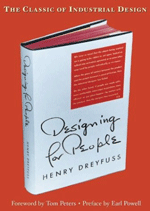 Henry Dreyfuss occupied a special place in the world of design. He created objects that made life’s repetitive and tedious tasks easier. He marketed his goods to a wide variety of clients and manufacturers. He took great care in understanding the user of these objects, and researched their habits, tendencies, and frustrations. He wrote about his endeavors in a classic book entitled Designing for People. He did it all, and did it with consideration; as an industrial designer, Dreyfuss was a humanist in every sense of the word.
Henry Dreyfuss occupied a special place in the world of design. He created objects that made life’s repetitive and tedious tasks easier. He marketed his goods to a wide variety of clients and manufacturers. He took great care in understanding the user of these objects, and researched their habits, tendencies, and frustrations. He wrote about his endeavors in a classic book entitled Designing for People. He did it all, and did it with consideration; as an industrial designer, Dreyfuss was a humanist in every sense of the word.
Whatever you design—websites, annual reports, logos, computer hardware, airplane heads-ups-displays, books, automobile interiors, or clothing—this book will enlighten your process. And if it doesn’t help in some way shape or form, I’d be surprised because Dreyfuss was a genius. In the introduction to this 2003 edition, Richard L. Simon explains why. A man capable of vast technical know-how, Dreyfuss had a playful and even empathetic way of working. At one time caught up in the goods and products, he always considered the user that would caress the object he designed.
Dreyfuss wrote Designing for People so that anybody could grasp what a designer does. He touched on process, materials, manufacturing, research, and the blending of art with science. To Dreyfuss, designers do not apply an aesthetic or surface on top of something. That, he labels, is a decorator. Instead, “An honest job of design should flow from the inside out, not the outside in” (18).
In addition to these insights, Dreyfuss peppered the book with a number of detailed illustrations. Some appear in the margins as quaint notations, others are highly refined studies. I found great enjoyment reading the human measurement and ergonomic studies in chapter two. Near the end of the book, I revisited these drawings again, reprinted from the 1967 edition with comparisons between humans from 1900 and 2000. Dreyfuss calculated an increase in our height and mass, forecasting the large-framed bodies of today. But people come in all shapes and sizes. The designer must be conscious of this when crafting telephones for the elderly, who have difficulty reading tiny numbers. Or when designing airplane seats that must accomodate varying degrees of width and weight. And beyond such utility, the designer must also be aware of fashion. Dreyfuss touches on survival form: a designer’s tendency to incorporate something old into something new. If it’s too new or too fresh, will it be appealing? Perhaps not, so it seems that nostalgia has a place. With survival form, it reminds people just enough of the past while incorporating something new into the scheme. Something “new” becomes “new and improved.”
The book’s opening was accessible and friendly, but I enjoyed the latter half most. After Chapter Twelve when Dreyfuss outlined five points to a successful design, I encountered chapters dedicated to client relationships, billing and financing, appraisals, frequently asked questions, and objects “not by design.” Ever wonder why refrigerators don’t have revolving shelves? Or why more print advertisers don’t use scented inks? Why more design isn’t shown in museums? Why barns are painted red? How long a design will last? What about whether or not good taste is acquired or inherent? Sleepless because of these issues? Start reading the book on page 200 to satisfy your curiosities.
Dreyfuss wrote Designing for People in 1955. He republished the book in 1967 with an additional chapter that addressed issues facing him and the culture of the 60s. This Allworth edition—published along with the Design Management Institute—contains the additional features. Titled Re-Appraisal, this bonus chapter has Dreyfuss’ assessments on television, automobiles, consumer waste, computers, and furniture. A designer creates so many objects for our convenience. A kitchen becomes full of electric do-dads and whiz-bang-choppers. Staring at any one or all of these earthly possessions, what is worthwhile and what is wasteful? The designer cannot answer such a question for the populace, but they can think for the user, think like the user, observe the user, and maybe through the final product, empower the user to consider what is worthwhile and what isn’t.
Designers must be considerate. In Designing for People, Dreyfuss does just that. He outlines the methods, means, and operations for considering the user and their domain. The forms created with that degree of care mean more, have appeal, and work better. Nearly fifty years after its first publication, hopefully the readers of this book will continue this noble endeavor because without sincere consideration a design will ultimately fail.
Designing for People by Henry Dreyfuss
256 pages, Softcover, 0.70 x 9.36 x 6.76”
Publisher: Allworth Press
ISBN: 1581153120






Emailing with an associate from Allworth Press, these questions arose. I feel they'd make for an interesting discussion, relating to the book and design in general:
These are valuable questions. They're as relevant to Dreyfuss' time as ours. Will we ever reach a solution? I think not. It's a perpetual problem...no?
On Sep.29.2004 at 10:14 AM